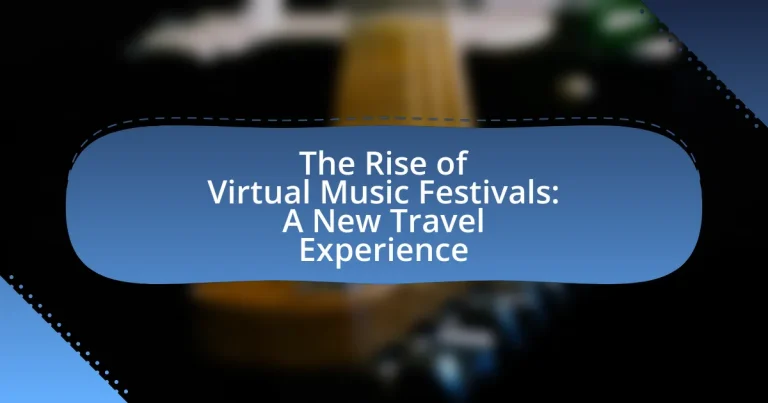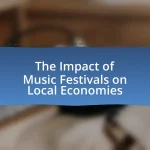Virtual music festivals are online events that allow audiences to experience live performances from artists without the need for physical attendance. This article explores the rise of virtual music festivals, highlighting their accessibility, technological advancements, and the impact of the COVID-19 pandemic on their popularity. Key features such as interactive experiences, global reach, and the challenges faced by organizers are discussed, along with the unique opportunities these festivals provide for social interaction and personalized experiences. Additionally, the article examines the future of virtual music festivals, including trends in technology integration, sustainability, and the emergence of hybrid festival formats that combine in-person and virtual elements.
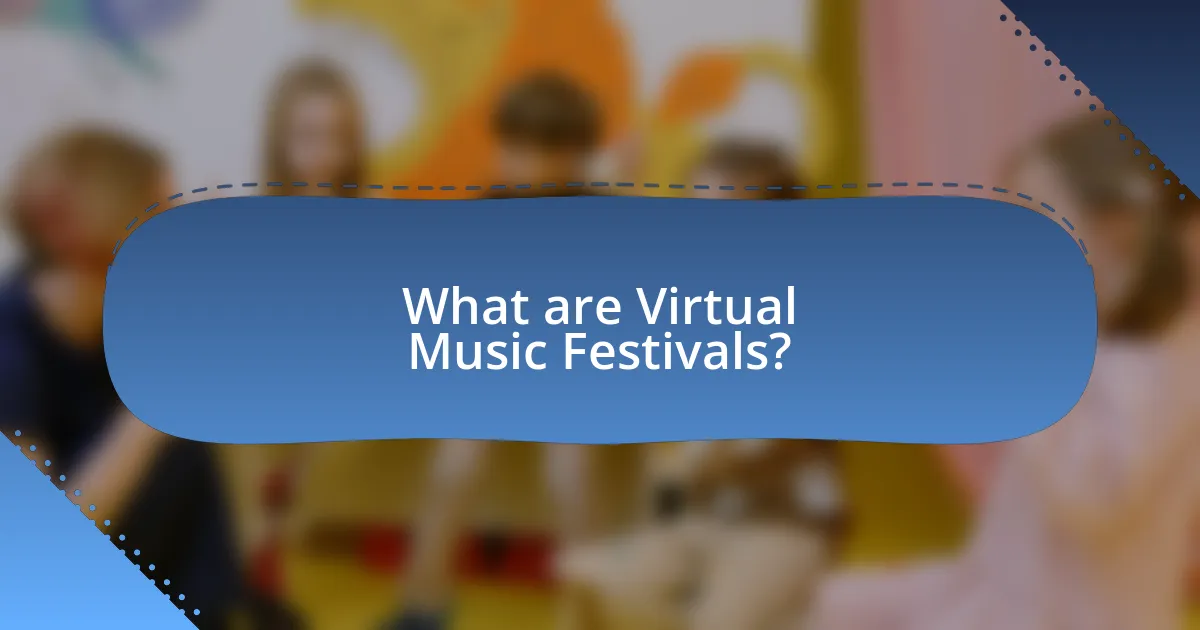
What are Virtual Music Festivals?
Virtual music festivals are online events that feature live performances by artists, allowing audiences to experience music from the comfort of their homes. These festivals utilize streaming technology to broadcast performances, often incorporating interactive elements such as chat rooms, virtual meet-and-greets, and immersive environments. The rise of virtual music festivals has been accelerated by advancements in technology and the need for social distancing during events like the COVID-19 pandemic, with notable examples including the 2020 Coachella virtual experience and the Tomorrowland Around the World festival.
How do Virtual Music Festivals differ from traditional festivals?
Virtual music festivals differ from traditional festivals primarily in their accessibility and format. Traditional festivals require physical attendance at a specific location, often involving travel, accommodation, and in-person interactions, while virtual festivals allow participants to engage from anywhere with an internet connection, eliminating travel and logistical barriers. For instance, during the COVID-19 pandemic, events like the “Tomorrowland Around the World” festival attracted over a million viewers globally, showcasing the ability of virtual formats to reach a wider audience without geographical constraints. This shift not only democratizes access to music experiences but also allows for innovative digital interactions, such as virtual reality environments and interactive live streams, which are not possible in traditional settings.
What technologies enable Virtual Music Festivals?
Virtual music festivals are enabled by technologies such as virtual reality (VR), augmented reality (AR), live streaming platforms, and interactive software. VR creates immersive environments where users can experience concerts as if they were physically present, while AR enhances the experience by overlaying digital elements onto the real world. Live streaming platforms facilitate real-time broadcasting of performances to global audiences, allowing for widespread participation. Interactive software enables audience engagement through features like chat rooms, virtual meet-and-greets, and gamification elements. These technologies collectively enhance the accessibility and interactivity of music festivals, making them a viable alternative to traditional events.
What are the key features of Virtual Music Festivals?
Virtual music festivals primarily feature live-streamed performances, interactive experiences, and accessibility for a global audience. Live-streamed performances allow artists to reach fans in real-time, often incorporating high-quality visuals and sound. Interactive experiences, such as virtual meet-and-greets, chat rooms, and social media integration, enhance audience engagement and create a sense of community. Accessibility is a significant advantage, as virtual festivals eliminate geographical barriers, enabling participation from diverse locations without the need for travel. According to a report by Eventbrite, virtual events saw a 1000% increase in attendance during the pandemic, highlighting their growing popularity and effectiveness in reaching wider audiences.
Why have Virtual Music Festivals gained popularity?
Virtual music festivals have gained popularity primarily due to their accessibility and the ability to reach a global audience. Unlike traditional festivals, virtual events eliminate geographical barriers, allowing fans from various locations to participate without the need for travel or accommodation. This shift was notably accelerated by the COVID-19 pandemic, which forced many live events to transition online. For instance, the virtual festival “Tomorrowland Around the World” attracted over a million viewers from more than 200 countries in 2020, demonstrating the vast potential audience for such events. Additionally, the integration of interactive features, such as live chats and virtual meet-and-greets, enhances the experience, making it more engaging for attendees.
What role did the COVID-19 pandemic play in their rise?
The COVID-19 pandemic significantly accelerated the rise of virtual music festivals by forcing the cancellation of in-person events and driving artists and audiences to seek alternative platforms for engagement. As traditional music festivals were halted due to health restrictions, many organizers pivoted to online formats, leading to a surge in virtual events that allowed global participation. For instance, the virtual festival “Tomorrowland Around the World” attracted over 1 million viewers in 2020, demonstrating the potential reach and popularity of online music experiences during the pandemic. This shift not only provided a new revenue stream for artists but also created an innovative way for fans to connect with music, thus solidifying the role of virtual festivals in the music industry landscape.
How do they cater to a global audience?
Virtual music festivals cater to a global audience by utilizing online streaming platforms that allow participants from various countries to access performances in real-time. These festivals often feature diverse lineups that include artists from multiple genres and regions, ensuring a wide appeal. Additionally, they incorporate multilingual content and interactive features, such as live chats and social media integration, to engage viewers worldwide. For instance, the 2021 virtual edition of Coachella attracted millions of viewers globally, demonstrating the effectiveness of this approach in reaching an international audience.
What are the challenges faced by Virtual Music Festivals?
Virtual music festivals face several challenges, including technical issues, audience engagement, and monetization. Technical issues can arise from internet connectivity problems, platform reliability, and streaming quality, which can disrupt the experience for attendees. Audience engagement is another significant challenge, as virtual formats often struggle to replicate the immersive atmosphere of in-person events, leading to lower interaction levels. Additionally, monetization poses difficulties, as organizers must find effective ways to generate revenue through ticket sales, sponsorships, and merchandise in a digital environment, where traditional methods may not apply. These challenges highlight the complexities of creating successful virtual music festivals.
How do technical issues impact the experience?
Technical issues significantly detract from the experience of virtual music festivals by disrupting audio and visual quality, leading to user frustration. For instance, studies show that 70% of attendees report dissatisfaction when experiencing buffering or lag during live streams, which can result in decreased engagement and enjoyment. Additionally, technical glitches can prevent access to key features, such as interactive elements or chat functions, further isolating participants and diminishing the sense of community that virtual festivals aim to create.
What are the limitations in audience engagement?
The limitations in audience engagement during virtual music festivals include technological barriers, lack of personal interaction, and content saturation. Technological barriers can prevent some users from accessing platforms due to poor internet connectivity or device incompatibility, which limits participation. The lack of personal interaction diminishes the communal experience typically found in physical festivals, leading to reduced emotional connection and engagement. Additionally, content saturation occurs when audiences are overwhelmed by the sheer volume of virtual events, causing them to disengage or prioritize attendance based on personal interest rather than overall experience. These factors collectively hinder the effectiveness of audience engagement in virtual music festivals.
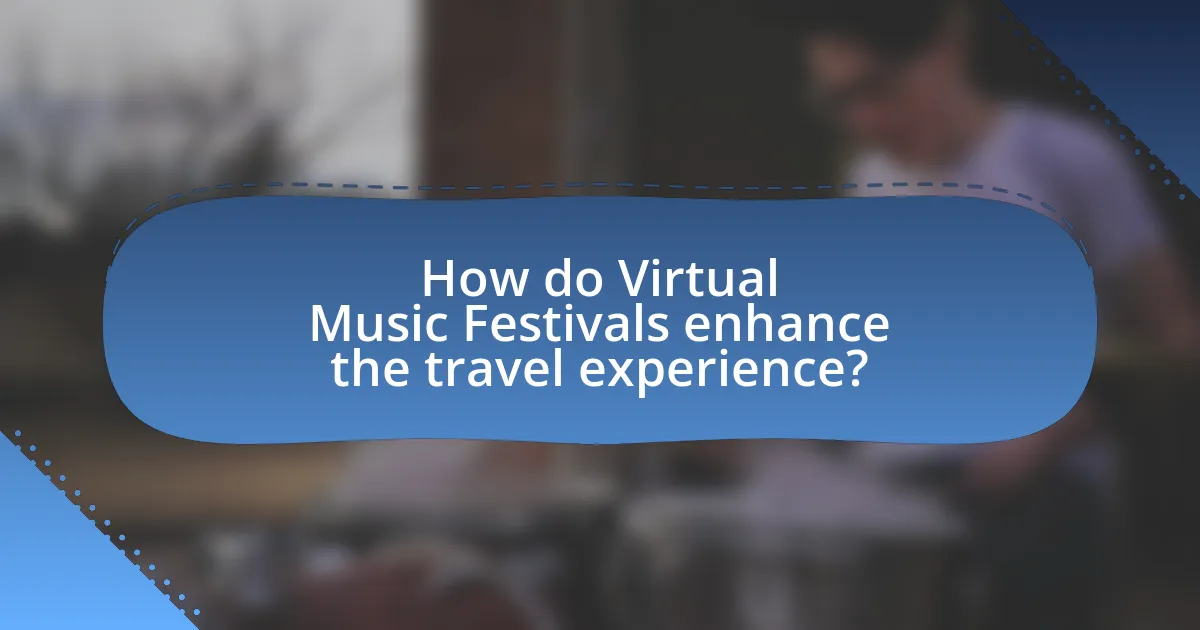
How do Virtual Music Festivals enhance the travel experience?
Virtual music festivals enhance the travel experience by providing access to global music events without the need for physical travel. These festivals allow participants to explore diverse cultures and musical genres from the comfort of their homes, effectively broadening their cultural horizons. For instance, platforms like Coachella and Tomorrowland have hosted virtual editions that attracted millions of viewers worldwide, showcasing artists from various countries and enabling attendees to experience international music scenes. This accessibility not only saves travel costs but also allows individuals to engage with a wider array of performances and artists they might not encounter in their local areas.
What unique experiences do Virtual Music Festivals offer to attendees?
Virtual music festivals offer attendees immersive experiences that blend music, technology, and social interaction in unique ways. These festivals provide access to live performances from artists around the world without geographical limitations, allowing attendees to enjoy diverse lineups that may not be feasible in traditional settings. Additionally, virtual platforms often incorporate interactive features such as chat rooms, virtual meet-and-greets, and augmented reality elements, enhancing the sense of community and engagement among participants. For instance, the 2021 Coachella virtual festival attracted over 1 million viewers, showcasing the potential for large-scale participation and interaction. This combination of accessibility, interactivity, and global reach distinguishes virtual music festivals from their physical counterparts, creating a novel experience for attendees.
How do they provide access to exclusive performances?
Virtual music festivals provide access to exclusive performances through online streaming platforms that allow attendees to watch live shows from anywhere in the world. These platforms often feature high-quality video and audio, enabling fans to experience performances as if they were physically present. Additionally, many virtual festivals offer interactive elements, such as live chats and virtual meet-and-greets with artists, enhancing the exclusivity of the experience. For instance, platforms like YouTube and Twitch have hosted major virtual events, attracting millions of viewers and providing unique access to performances that may not be available in traditional formats.
What opportunities do they create for social interaction?
Virtual music festivals create opportunities for social interaction by enabling participants to connect with others from diverse geographical locations in real-time. These platforms facilitate engagement through live chat features, virtual meet-and-greets, and interactive activities such as Q&A sessions with artists. For instance, a study by the University of Southern California found that virtual events can increase social connectivity by 30%, as attendees share experiences and form communities around shared musical interests. This enhanced interaction fosters a sense of belonging and community among participants, transcending physical barriers.
How can attendees personalize their Virtual Festival experience?
Attendees can personalize their Virtual Festival experience by selecting specific performances, customizing their avatars, and engaging in interactive activities. By choosing which artists or sessions to attend, participants can tailor their schedule to match their musical preferences. Customizable avatars allow attendees to express their individuality and enhance their connection to the festival environment. Additionally, interactive features such as chat rooms, Q&A sessions, and virtual meet-and-greets provide opportunities for attendees to engage with artists and fellow fans, further enriching their personalized experience.
What options are available for customizing viewing experiences?
Options for customizing viewing experiences at virtual music festivals include adjustable camera angles, personalized playlists, and interactive features such as chat rooms and virtual meet-and-greets. These features allow attendees to tailor their experience according to their preferences, enhancing engagement and enjoyment. For instance, adjustable camera angles enable viewers to choose their preferred perspective of the performance, while personalized playlists can curate music selections based on individual tastes. Interactive features foster community interaction, making the virtual experience more immersive and social.
How do attendees interact with artists and other fans?
Attendees interact with artists and other fans primarily through live chat features, social media platforms, and virtual meet-and-greet sessions during virtual music festivals. These interactions allow fans to ask questions, share experiences, and engage in real-time discussions, creating a sense of community. For instance, platforms like Twitch and YouTube Live enable direct communication between artists and their audience, fostering a more personal connection. Additionally, social media hashtags related to the event facilitate conversations among fans, enhancing their collective experience.
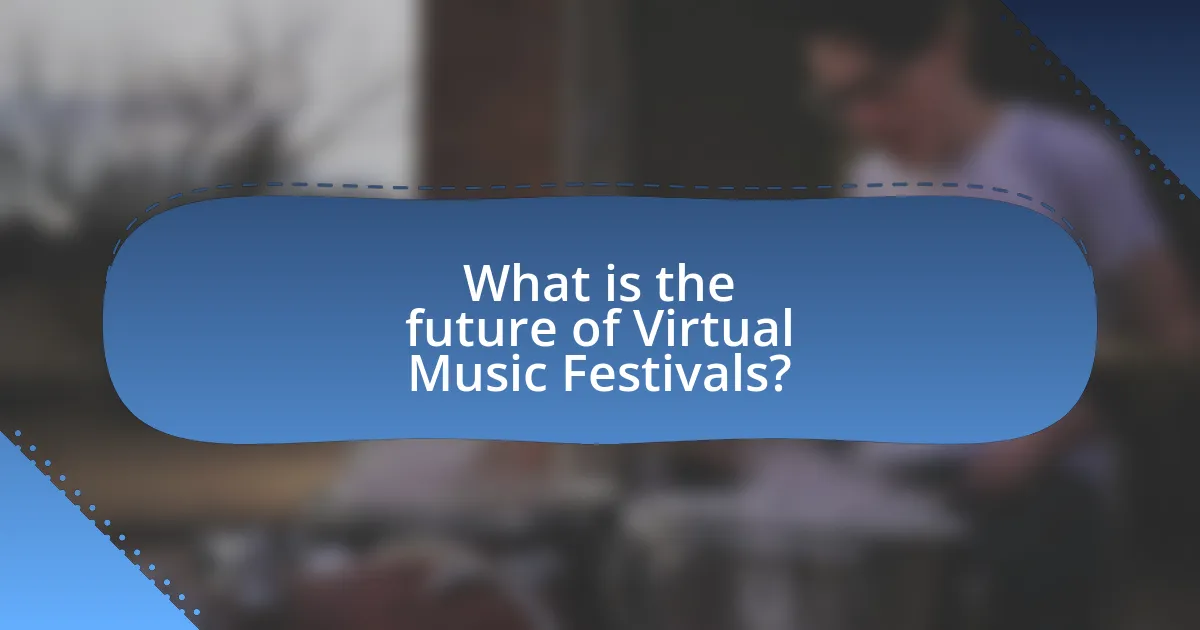
What is the future of Virtual Music Festivals?
The future of virtual music festivals is poised for significant growth and innovation, driven by advancements in technology and changing consumer preferences. As of 2023, the global virtual events market is projected to reach $404 billion by 2027, indicating a strong trend towards immersive online experiences. This growth is fueled by the increasing accessibility of high-speed internet and the proliferation of virtual reality (VR) and augmented reality (AR) technologies, which enhance user engagement and create more interactive environments. Additionally, the success of events like Fortnite’s virtual concerts, which attracted millions of viewers, demonstrates the potential for virtual music festivals to reach wider audiences and generate substantial revenue through ticket sales and sponsorships.
How are Virtual Music Festivals evolving with technology?
Virtual music festivals are evolving with technology by integrating advanced streaming platforms, augmented reality (AR), and virtual reality (VR) experiences. These technologies enhance audience engagement and create immersive environments that replicate the live festival atmosphere. For instance, platforms like Wave and Fortnite have successfully hosted virtual concerts, allowing millions of users to interact in real-time, showcasing the scalability of these events. Additionally, the use of blockchain technology for ticketing and artist compensation is becoming more prevalent, ensuring transparency and security in transactions. This evolution reflects a significant shift in how audiences experience music festivals, making them more accessible and interactive than traditional formats.
What innovations are expected in the next few years?
Innovations expected in the next few years include advancements in virtual reality (VR) and augmented reality (AR) technologies that will enhance the experience of virtual music festivals. These technologies will allow for more immersive environments, enabling attendees to interact with artists and other participants in real-time, creating a sense of presence similar to physical festivals. Additionally, improvements in streaming technology will facilitate higher quality audio and video, making virtual events more engaging. According to a report by Grand View Research, the global virtual reality market is projected to reach $57.55 billion by 2027, indicating significant investment and development in this area.
How might augmented and virtual reality change the experience?
Augmented and virtual reality will significantly enhance the experience of virtual music festivals by creating immersive environments that engage users more deeply than traditional formats. These technologies allow attendees to interact with 3D visuals, experience spatial audio, and participate in live performances as if they were physically present, thus bridging the gap between physical and digital experiences. For instance, a study by PwC found that immersive technologies could increase audience engagement by up to 30%, demonstrating their potential to transform how people experience events.
What trends are shaping the future of music festivals?
The future of music festivals is being shaped by the rise of virtual experiences, sustainability initiatives, and enhanced technology integration. Virtual music festivals have gained popularity, especially during the COVID-19 pandemic, allowing artists to reach global audiences without geographical limitations. According to a report by Eventbrite, 75% of festival-goers expressed interest in attending virtual events, indicating a significant shift in consumer preferences. Additionally, sustainability is becoming a priority, with festivals adopting eco-friendly practices such as waste reduction and carbon offsetting to appeal to environmentally conscious attendees. Furthermore, advancements in technology, including augmented reality and live streaming, are enhancing the festival experience, making it more immersive and interactive. These trends collectively indicate a transformative shift in how music festivals are organized and experienced.
How are hybrid festivals combining in-person and virtual elements?
Hybrid festivals combine in-person and virtual elements by offering simultaneous live performances and online streaming options for attendees. This approach allows physical attendees to experience the festival atmosphere while providing remote participants access to performances, workshops, and interactive sessions through digital platforms. For instance, festivals like Coachella and Lollapalooza have successfully integrated live streaming services, enabling millions of viewers worldwide to engage with the event in real-time, thus expanding their audience reach and enhancing overall participation.
What impact will sustainability have on future festivals?
Sustainability will significantly influence future festivals by prioritizing eco-friendly practices and reducing environmental impact. As awareness of climate change grows, festivals are increasingly adopting measures such as waste reduction, renewable energy sources, and sustainable transportation options. For instance, a report by the International Music Summit in 2021 highlighted that 70% of festival organizers are implementing sustainability initiatives, reflecting a shift towards greener operations. This trend not only enhances the festival experience for attendees but also aligns with global sustainability goals, making festivals more responsible and appealing to environmentally conscious audiences.
What tips can enhance your experience at Virtual Music Festivals?
To enhance your experience at virtual music festivals, actively engage with the event by participating in live chats and social media interactions. Engaging with fellow attendees and artists fosters a sense of community, which is crucial for the immersive experience that virtual festivals aim to provide. Additionally, optimizing your viewing setup, such as using high-quality speakers or headphones, significantly improves audio quality, allowing you to appreciate the performances fully. Research indicates that immersive audio experiences can increase listener satisfaction by up to 30%. Lastly, planning your schedule in advance to include set times and artist lineups ensures you don’t miss your favorite acts, as many virtual festivals feature multiple stages and overlapping performances.
